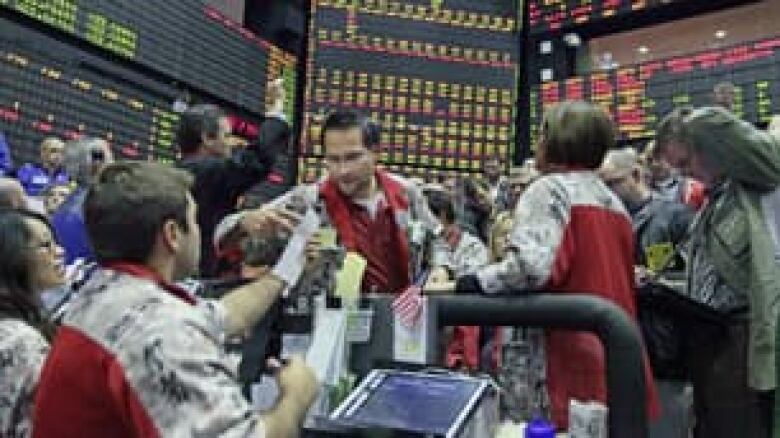Soaring commodities raise global food worries
U.S. move to re-regulate trading renews debate over role of speculators
Commodity prices could be poised to soar again in 2011, adding to strong gains in 2010.
That would benefit Canada, given that half the stocks on the Toronto Stock Exchange are energy or raw material companies, butit has raised concernsfor the world's poorest countries.

The price rise after the recession was "the sharpest recovery ever," Bart Melek, Global Commodity Strategist at BMO Capital Markets told a media conference call on Dec. 14.
"We came off theworst economic performance since the Great Depression and 10 to 11 months into [the recovery], commodities are near their peak."
The average price of gold and silver for the year rose 23 per cent compared with2009, while copper gained close to 45 per cent. Palladium was up almost 90 per cent. Strong demand from emerging economies such as China, India, Brazil and Russia could push prices higher in 2011.
"They're still young economies," said Melek, "they need everything from bridge infrastructure to power line infrastructure."
Agricultural commodities have also soared.
From June to December, wheat, rice, maize and soybeans prices gained by double-digit percentages, with wheat up 69 per cent and maize higher by 53 per cent.
Since June 2008, speculative money has flowed into commodities markets at a "blistering pace," according to Bart Chilton, commissioner of the U.S. Commodity Futures Trading Commission, with positions held by hedge funds, index funds and pension funds at their highest ever, representing more than $149 billion.
Deregulated in 2000
That flow has steadily increased since the U.S. deregulated its commodity markets 10 years ago.
With the American governmentnow moving to bring those markets back under tougher rules, the debate over whether speculation pushes up prices independent of supply and demand will likely intensify.
Passage of the U.S. Commodity Futures Modernization Act in 2000 ended the regulation of private transactions in commodity derivatives, or securities based on the price behaviour of an underlying commodity.
Hundreds of billions of dollars of speculative funds flowed into a market the chief function of which had been to allowproducers to protect themselves from a price fall or processors or other users to protect themselves from price increases.
Commodity prices spiked in the years following, although there was a debate about whether that was caused by the influx of money or the increase in growth in emerging markets and increased demand for bio-fuels.
The debate became more intense in 2008-09, when 61 countries across Africa, Asia, Latin America and the Caribbean experienced serious food riots and hoarding as food prices soared.

That prompted the Minneapolis-based Institute for Agriculture & Trade Policy, in November 2008, to blame speculation as "a major contributor to extreme price volatility, which is skewing agriculture commodity markets to such a degree that both farmers and consumers are losing out."
A senior policy analyst for the Institute, Steve Suppan, told CBC News that trading by speculative funds almost uniquely translates into more buy orders, putting upward pressure on prices.
Deregulation, he said, attracted a "flood of hot money" into the market by investors "who do not have any interest in hedging the commodity and so they can plunge large amounts of capital into a market but without caring about supply and demand fundamentals."
An opposing argument to that view is, that since speculators actually close their trades before they must take delivery, they aren't affecting actual supply and demand.
Lobbying to make the commodities market more transparent led the U.S. Congress in June to pass the Dodd-Frank Wall Street Reform and Consumer Protection Act, which will limit how many futures contracts a speculator can own.
It will also require that even private commodities trades be recorded and settled with the terms published on public exchanges, so regulators can see when the position limits are being exceeded.
How tough those limits are depends on the interplay of American politics before the deadline set by the act for having all the rules in place by July.
Food prices near 2-year highs
In the meantime, food prices over 2010 have followed agricultural commodities higher.
"I think everyone is wondering if we are going to have a repeat of 2008 when there were food riots around the world," Johanna Nesseth Tuttle, director of the Global Food Security Project at the Center for Strategic and International Studies in Washington, said in September.
And in November, the Food Price Index compiled by the Food and Agriculture Organization (FAO) which measures monthly price changes in a basket of foods including cereals, oilseeds, dairy, meat and sugar spiked to 205 points, just seven per cent below its June 2008 peak.
The FAO didn't raise concerns about speculation, but attributed the rise mainly to the effect on international wheat prices ofsevere drought in Russia and the country's subsequent restrictions on wheat sales.
Still, for Suppan, the concern is for the world's poorest countries.
Their importers are more likely to bring in a commodity, such as wheat, in its unprocessed form rather than as flour.
The prices of those raw commodities are more directly affected byfutures prices setby the markets, he said, and those importers are less able to deal with volatilitybecause their market power is dwarfed by the larger participants in the commodities markets.
"[Consumers in poor countries]will feel the impact of futures price volatility more directly because if their importers can't figure out where their futures prices are going, they will not know when to forward contract, or at what price to forward contract their imports."












_(720p).jpg)


 OFFICIAL HD MUSIC VIDEO.jpg)
.jpg)



























































































